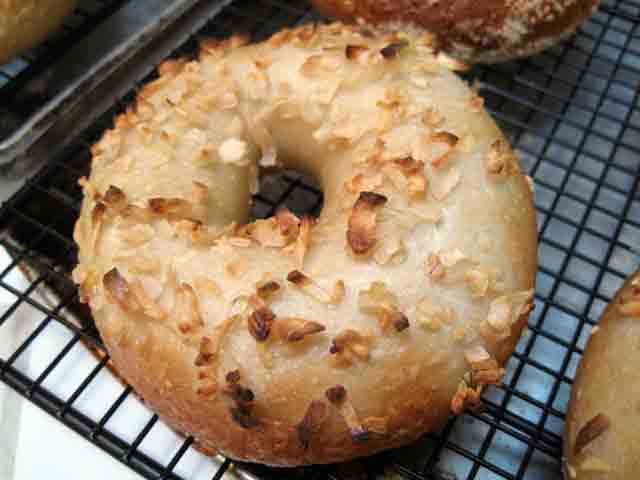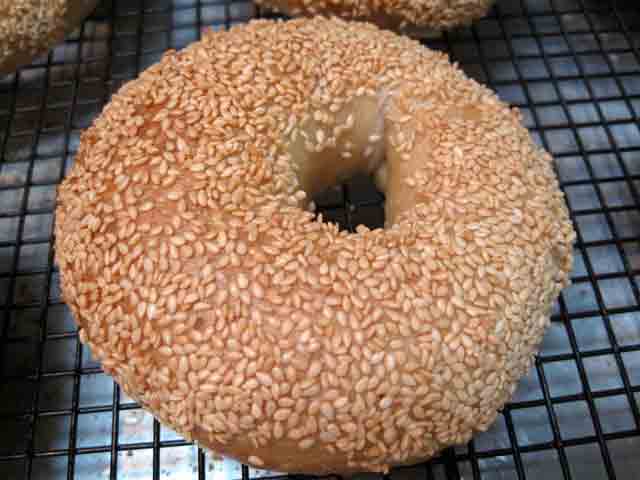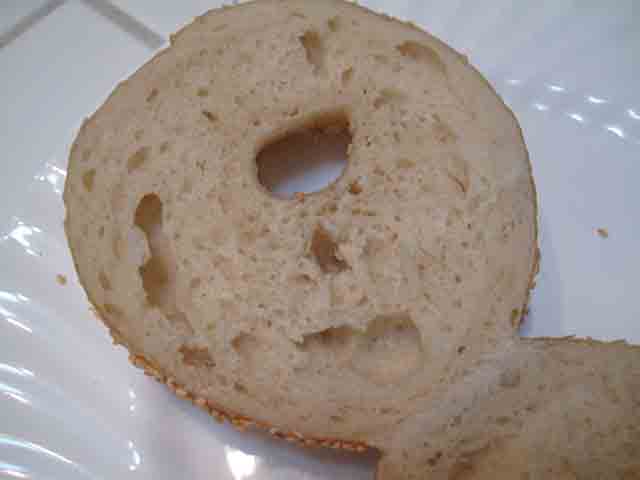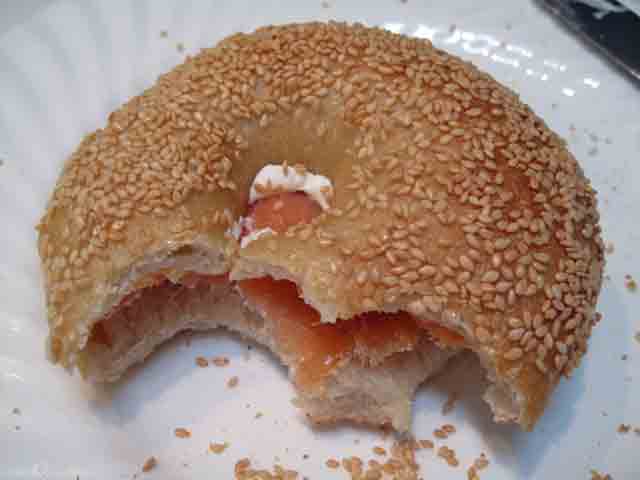I'd bought some smoked salmon to have with Greenstein's sour rye which I baked last week. My wife's comment was, "It's too bad we don't have bagels." It happens I had a couple bags of Sir Lancelot (KAF's high-gluten flour) in the pantry, as well as all the other necessary ingredients, on hand. I also had a lecture to prepare, and I was running out of excuses to delay finishing it. So, I made bagels.

I used the formula from Peter Reinhart's "The Bread Baker's Apprentice." This entailed making a sponge, then a final dough which is mixed and immediately divided, then shaped and retarded overnight before boiling, topping and baking. I'd used this formula before, but never with high-gluten flour.
The dough was a pleasure to work with, and my shaping method "clicked" with this batch. I shaped each piece as I would to make challah, using Glazer's method of flattening the pieces then rolling them up into tubes. I then rolled each tube as if I were making baguettes to about 9 inches, shaped them over my hand with the ends together in my palm. I gave the ends a gentle squeeze and then rolled the sealed ends on an un-floured board to seal them. Then, I gently stretched each resulting ring gently to enlarge the hole and placed each bagel on a sheet with oiled parchment paper for retarding.
The next day, after boiling the bagels in water with baking soda, I topped them with sesame seeds or re-hydrated onion flakes and baked them.

Onion bagel

Sesame bagel

Bagel crumb
Although the crumb was very well aerated and looked "fluffy," the bagels were delightfully chewy. They had a delicious flavor plain, without any topping, and were even better with cream cheese and smoked salmon.

Bagel with cream cheese and lox
David
Submitted to YeastSpotting
- dmsnyder's Blog
- Log in or register to post comments
wow those are really breautiful looking. I have never made bagels. Mike used to buy them a lot and has quit eating them for some time now.. He can afford the carbs in them so maybe someday I will get around to trying to make some. They always looked like they would be fun to make. Years ago in a hotel resturant I worked in we would love them toasted with cream cheese for breakfast. I like them now with cranberries in them.
Sylvia
It's been a long time since I last made bagels. I don't know why I waited so long. We really like them, and the closest source of decent bagels is 3 hours away, assuming those sources even are still in business!
When I made bagels before, I kind of struggled with shaping. I guess I've learned a lot of different shaping and dough handling techniques since then. I really had fun, feeling almost competent, shaping this batch.
David
David - Those look beautiful! That's the technique we use at work to shape them. Have you tried using non-diastatic malt (or even honey) in the water when you boil them? It gives the bagels a wonderful sheen.
I find bagel dough one of the most challenging to get right. A little too dry and it's impossible to roll them out properly. A little too wet and you have similiar problems. What to me makes the mix so difficult is that (and this is using a commercial spiral mixer) on speed 1 you don't really get a good idea of whether the hydration is just right. It takes going to speed 2 and about 5 minutes of mixing before the dough shows its 'true colors.' Then you are either in good shape, or find yourself going back to speed 1 and adding flour or water as the dough demands.
If you make these in any quantity you can freeze them after proofing, and then a day before baking just place them in the refrigerator for about 24 hours, then boil them after a short rest and they turn out beautifully!
Larry
There is malt powder in the dough. When the bagels hit the alkalinized boiling water, the turn brownish and shiny.
I mixed the bagel dough in the Bosch, figuring it would strain the KitchenAid and make it walk off the counter, if I turned my back on it. I followed Reinhart's procedure, which is to hold back 3/4 cup of flour and add it to stiffen the dough, as needed. I stopped the Bosch a few times during the mix to test the dough consistency and, later on, the development. Just following Reinhart's directions (and with careful measurement of ingredients), the dough consistency came out perfectly - Silky, but not even a bit tacky. I mixed in the Bosch at Speed 2 for about 10-11 minutes to get a beginning window pane.
I like the idea of freezing after proofing. I wish I'd known about this yesterday. Would you freeze the bagels after the overnight cold retardation or right after the brief proofing (and passing "the float test")?
David
Hi David,
I'm not a mad bagel fan; the chewy texture from the gelatinising boil has never really wowed me. But, I'd like to get the boil bit just right, and it can be a bit tricky.
You've obviously got everything spot-on; these look wonderful. I agree with Larry that you absolutely have to get the dough mixing right - so I would always be using our strong flour over here in the UK. Our plain flour would not be up to the job.
Anyway, i think this overnight retard is very significant, and a great idea; the freezing goes a stage further. Can you tell me about any recovery time? Do you allow the bagels to come back to room temperature before the boiling?
Best wishes
Andy
As Larry says, the bagels go directly from the fridge into the boiling water. Remember, they are fully proofed (although it only takes about 20 minutes) before being retarded. They have their "oven spring" primarily in the boiling water. There is minimal, if any, additional spring in the oven.
I have no experience with frozen bagels, but Larry's response makes perfect sense to me.
BTW, the chewiness is very much influenced by how long you boil the bagels. Reinhart specifies 1 minute, then flip the bagels, then another minute. Ciril Hitz, in one of his You-Tube videos, says 10 seconds per side. I boiled about 30 seconds per side, and the bagels were plenty chewy for my taste. I would boil longer if using weaker flour than Sir Lancelot.
David
David- Actually, we've tried steaming vs. no steaming of the bagels in the oven, and there is a noticeable difference in the size of the bagels (they're bigger) when steamed. Of course, this is steaming with a commercial oven, so the results may not be the same at home.
Larry
David, Andy - We freeze the ones we won't be baking the next day after they've proofed. As for using the frozen ones, we experimented with bringing them up to room temp vs. plunging them into the boiling water right out of the walk-in where we let them defrost for about 24 hours after taking them from the freezer. In our experience, it's better to go with the latter (right into the water from the walk-in). Otherwise we had issues with them sticking to the parchment (even with corn meal) and overproofing.
I haven't tried these at home for the very reason you mention David. I have a not so powerful Hamilton Beach that I'm afraid the bagel dough would destroy.
Larry
I sure wouldn't want to come back as a bagel in my next life. A rough mix, a long period in the cold (or freeze??), then slumped into boiling water (head first even), before being baked, chilled and finally toasted. If you're really unlucky, you make another detour into the freezer after being chilled (and before being toasted).
Ma vie c'est de la merde!
Ahhhh ... But then you end your life covered with cream cheese and smoked salmon. It's all worth it!
David
Once again, please stop posting pictures of your amazing baking creations. I keep chipping my teeth on my flat screen monitor. ;-)=
Great work!
dsoleil
I recommend that you install a mouth guard, if necessary, prior to reading my TFL posts. These are readily obtained from sporting goods stores and dental supply houses. However, I find that holding half a bagel between your teeth works as well, costs less and tastes better. Just be prepared to blow out the seeds that fall between your keyboard keys.
Hope this helps.
David
Hi David,
Those are good looking bagels! I'd love to give it a try. However, I only have Reinhart's Crust and Crumb book, which does has a recipe for sourdough bagels. Do you happen to know if the recipe is the same as the one in BBA? I guess you have to have the C&C book in order to compare?...hmm...
Thanks,
Michelle
C&C has formulas for both yeasted and sourdough bagels. I have the book, but I haven't made either of these formulas.
Comparing the formulas in C&C and BBA, they are more similar than not. Both use a "poolish-type" sponge and overnight retardation. The main differences are that the C&C version ferments the sponge longer and calls for a much longer proofing of the shaped bagels. I haven't worked out the baker's percentages in each (PR does it differently in the two books), but maybe there is less yeast in the C&C version. When I sliced a bagel that had just cooled, it had a somewhat yeasty aroma, although it didn't taste a bit yeasty.
I mostly bake with sourdough, and I really should try the SD bagels in C&C.
With some formulas that appear in both of these books, I feel that PR dumbed them down a bit for BBA. This is surely true for the San Francisco Sourdough, and, maybe, for the bagels.
Anyway, if you have C&C, I wouldn't go out an buy BBA for the bagel formula.
David
Hi David and Larry,
Thanks both for your insight into when to boil the bagels. I was wondering if the impact of boiling water on a cold bagel was too much "shock", as Hans was joking about. But, yes, I take your point that the bagels are at full proof. I would suggest proving your bagels on a piece of silicone paper which has been lightly greased with shortening; this is what I do with doughnuts in my teaching classes. That way you can lift each bagel easily using a fish slice.
Also, levels of gelatinisation will be determined by levels to which the starches in the bagel dough are heated. So, yes, long boiling equates to increased chewiness. Larry's point about oven expansion is very interesting. The expansion is not coming from the yeast, as that should be killed off in the boil up. Starches will not burst until they reach a temperature in excess of 70*C, by which time the yeast cells will long be dead. So, yes, Larry, I think you got it right by making specific reference to a commercial oven. Steam will be injected under pressure. For sure the extra oven rise you are talking about is coming from steam pressure not yeast activity.
On your discussion of sourdough bagels, I'm unapologetic on this one. Same for croissants and same for [English?] Muffins. No place for sour in these formulae for me. I would use malt extract and a pinch of diastic malt powder for dough improvers, and use a relatively short bulk fermentation time. The sour will simply breakdown the condition of the dough and render it too unstable just at the all-important boiling time.
Sourdoughs and natural leavens take centre space in my baking; but there is a time and a place for everything. I'm sure some people here are not going to agree with me on this, but I'm pretty sure I have a good understanding of both the benefits, and the drawbacks of natural pre-ferments.
Best wishes, and thanks again
Andy
I'm surprised that steaming the oven would increase oven spring of bagels. My understanding of the purpose of steaming is to keep the surface of the bread flexible to permit expansion during oven spring. But, after boiling, the bagels have a pretty firm crust already.
Reinhart does not prescribe baking bagels with steam. Interestingly enough, Greenstein does.
What are your thoughts, Laryy and Andy?
David
I disagree on this point Andy. The boiling time is so short that only the outermost part of the dough is warmed above 140F, leaving much of the live yeast intact for later expansion. I doubt the live steam or steam under pressure has much effect on anything but the crust and flexibility of the crust. If anything the steam cools the oven down, allowing a longer period of oven rising.
Personally, I think the physics of steaming and the forces in play during oven spring are misunderstood by many. The successful use of a cover during the first minutes of baking should make a person wonder if the dough is simply being protected from the harsh heat while it is warming and springing.
Eric
What is the point of the boiling then?
Surely you are looking to gelatinise the starch to create a chewy texture in the bread?
Thanks
Andy
David, Andy, Eric-
Wow, what interesting questions this has raised. I am not certain what causes this, only that experience has shown it to be true. I have one possible explanation that springs (sorry, no pun intended) to mind, however: We only boil our bagels for about 45 seconds per side (we boil in batches of a dozen, so the 45 sec. is an approximation - some are being turned earlier that others). So, maximum time in the water is about 1 1/2 minutes. Taking into consideration that the bagels have come straight out of a walk-in where the temperature is around 40 F, perhaps Eric is correct that not all the yeast is being killed off during the boil. Otherwise, I think Andy's point that residual starch expansion is still possible could account for this as well.
I may try to poke one with a thermometer to see what the internal temp reads before baking but after boiling.
Larry
David, Eric, Andy-
Ok, I finally got around to sticking a thermometer into a bagel during our bake today. I boiled one exactly 45 seconds per side, so 1 1/2 minutes total immersion in boiling water. The internal temp reading was 121.8° F or about 50° C. That's well below the thermal death point for yeast.
However, if you are boiling them for nearly 2 minutes per side to develop a very chewy bagel, I suspect that the internal temperature will probably exceed 140° F.
So, to steam or not to steam? Seems to me that may well depend on how chewy you like your bagels.
Larry
Hi All,
I think Eric prefers to boil the bagels for less time than this; is that right?
At 50*C yeast is pushed; I teach it is killed off at 53*C. Larry, your 140F equates to 59.94*C: I don't think that's right. Its optimum temperature is the same as ours: 37*C!!
I'm still uncertain about the purpose of boiling these things if not to gelatinise the starch??
Best wishes
Andy
Hi Andy - I've been taught and read that yeast dies at 140° F which translates to about 60° C. That was my reference. I agree that its optimal temp is much lower.
My conjecture was that at 121.8° F (50° C) the yeast would still be alive and active enough to provide the oven spring I've witnessed with our bagels.
Best-
Larry
Hi Larry, we'll have to agree to differ on the 7*c differnece...however, the yeasts will not be that happy at that high a temperature, that's for sure.
We've run tests on 400g tin loaves showing it takes nearly 10 minutes for the middle of the loaf to reach 53*C. Oven spring is over before then!
Yeasts really don't thrive at that high a temperature.
But I'm waiting for Eric to come in on this. I think he boils bagels for less time than you did in your experiment.
Also, starch gelatinisation takes place around 70*C. So, I'm still not seeing the point of the boiling phase, if it is not to achieve at least some degree of gelatinisation.
I wish I even liked the things in the first place!
Best wishes
Andy
Have to disagree with you on this point, Andy. I make sourdough bagels every week and have been doing so for the best part of a year. I have tweaked my recipe and baking temps/times so that they turn out just about perfectly every time. I have to say, they're the best bagels I've ever tasted - and I've been through a few! Just the right amount of chew, lovely crumb and superb flavour. I take no personal credit for this, I hasten to add - it's all in the ingredients, recipe and process.
I've made the dry yeast version from BBA and IMO the SD ones I'm turning out are superior. No reflection on David's bagels in that comment - they look lovely. I am simply speaking my truth. The recipe I use is an adaptation of one posted by an amateur home baker (I think I came across it on Sourdough Companion, but it might have been here...will check and get back on this if anyone is interested).
I dunno about SD and English muffins - no experience with SD there. And I would have been inclined to agree with you on croissants, until I came across a post by LeadDog featuring some fatabulous looking SD croissants he made. Yeeeeaahh, but I bet they're not light and airy like great croissants should be, I thought, but LeadDog responded to my mildly worded query on that point with an assurance that they were, indeed, "VERY light"...!
I'm sure there are some bready thangs that SD just isn't suited for, but in my experience bagels, pizzas (and panettone!!) are not among them...in view of LeadDog's post, maybe croissants aren't either!
I've personally not made either SD bagels or SD croissants, but I'd be very happy to get your recipe for SD bagels, rossnroller. Please post it. I'd love to try it.
Regarding croissants, Andy: If you have access to a copy of Michel Suas' "Advanced Bread and Pastry," you might find his comparison of croissants made with different pre-ferments (including levain) of interest. He has something like 5 or 6 croissant formulas in AB&P, not counting those for other pastries made with the same laminated doughs. Suas is very analytical regarding the effects of each pre-ferment (or none) without clearly endorsing any one of the formulas as entirely superior to all the others.
David
Hi David. Will certainly get back with my SD bagels recipe. Nearly 2am here, so will type it up and post tomorrow hopefully, or next day at latest. Better get some shuteye now!
Cheers
Ross
Hi David,
Thank you very much for directing me to Michel Suas. It's my most recent purchase for our College Library to keep my students' research going.
I used this text extensively when researching baguettes for the Lesaffre Competition recently...along with Calvel and Hamelman.
I'm on Easter break at the moment, but I will have a good read of this when I get back to work. Something to look forward to.
I'm still struggling to get enthusuastic about bagels, although I was really interested in what both Eric and Larry were writing about. Let's hope we can try and take that a stage further.
In the meantime, I've just posted about my latest Hamelman-esque offerings: http://www.thefreshloaf.com/node/17308/semolina-durum-bread-and-sourdough-seed-bread
Best wishes
Andy
Hi David. Just a quick note to let you know I have posted my sourdough bagels recipe. See here.
Cheers
R
I should have clarified that I'm also mostly interested in sourdough related stuff, so yes, I meant the SD bagel recipe in C&C. Maybe one day I'll give it a try, and will post if I have any success with it :) Thanks again.
Hi Larry, David and Eric,
I just found this pdf on the net; here's the reference: http://www.lallemand.com/BakerYeastNA/eng/PDFs/LBU%20PDF%20FILES/1_20BAGL.PDF
Regarding why the bagels are boiled, this is what it says:
"serves three main functions:
Boiling
1. To give a shiny appearance and a
thick, crisp crust. This is a result of the
gelatinization of starch on the surface that
sets the crust.
2. To inactivate the yeast. Bagels should
be boiled long enough for the internal temperature
to reach 130°F; at this point, yeast
fermentation has ceased.
3. To give a chewy mouthfeel characterized
by low volume and high density
from a high-gluten flour.
If bagels expand wildly in the oven,
they probably were not boiled long enough,
have a yeast level that is too high, or both.
Boiling time is generally one minute on
each side for a three-ounce bagel.
My reading is that the gelatinisation is only required on the surface, and that is to give the shine to the dough surface. My theory that more gelatinisation is needed to ensure the dough is chewy, is not quite right. But, I think my understanding that the boiling will kill yeast activity is endorsed in this paper.
Best wishes
Andy
I've been using Maggie Glezer's bagel recipe (A Blessing of Bread). I have not let the shaped bagels rise before they go into the overnight refrigeration (where they usually rise slowly, just a modest amount). I find the way they behave in the boiling bath (floating right away or after a brief sinking spell) depends on how much yeast I've used. Glezer specifies instant yeast; I have used both and like active dry better (allowed to activate in warm water with a touch of sugar and flour--but NOT any barley malt syrup, which seems to catch the yeast and render it helpless). Any ideas regarding this?
Joyful
A foolproof way I've found to get proofed bagels into boiling water without deforming is to proof them on parchment paper, then with scissors cut the paper between each bagel, so each bagel is sitting on its individual square. Pick up each square, tilt it over the water, and like Aladdin on his flying carpet, off they go, delicately tumbling into the boiling water!